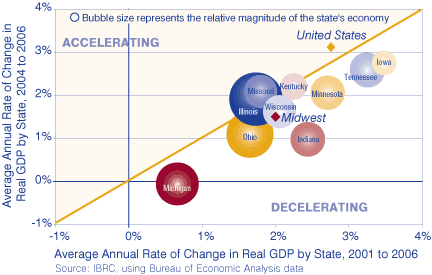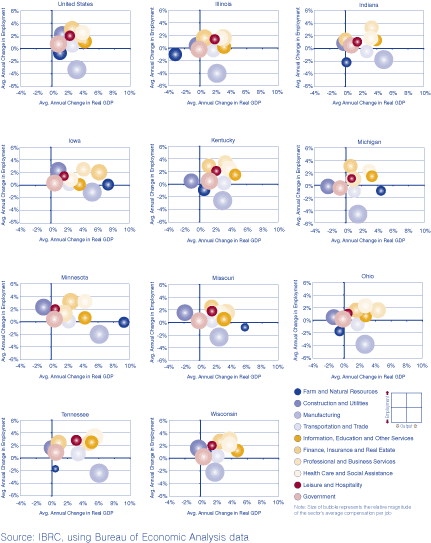Recovery and Restructuring Part I: The Indiana Economy Since 2001
The century did not start well, at least in economic terms. Investment in the United States dropped precipitously and with it, economic and employment growth. The nation as a whole suffered and the manufacturing sector shed jobs at a phenomenal pace. In 2003, the U.S. economy began its recovery and by late in the year, was growing at a healthy clip.
The Indiana economy was subject to the same forces as the U.S. economy. Not only did Indiana (and the Midwest in general) undergo the loss of manufacturing jobs due to the recession of 2001–2002 and the shift of the economy to the service sectors, but the struggling automotive industry put additional stresses on Indiana's economic and employment growth after the recovery was well underway.
The traditional view is that Indiana's economy is not only tied to manufacturing, it is tied to automobile manufacturing. Therefore, what the national economic expansion gave starting in 2003, the havoc in the automotive sector took away. Is this news? Hardly. There isn't a week that goes by, so it seems, that one hears of another auto-related plant destined for closure.
But the data released earlier this year by the Commerce Department present a mixed picture of the economic transitions that Indiana has undergone. These data also provide some clues as to what the future may hold for the state. The news isn't all bad. The contributors to the June issue of InContext used these data to describe several elements of the Hoosier employment picture. (1) This article, part one of a two-part series, picks up on a couple of those themes and describes how Indiana's economy has recently changed.
Indiana's growth rate in real gross domestic product (GDP) was well behind most other states and the nation as a whole from 2001 to 2006. However, compared to the Midwestern states, Indiana's economy grew 0.5 percentage points faster from 2001 to 2006, as depicted in Figure 1. (2001 was selected as the starting point because that is the year when GDP growth slowed to almost zero.) Figure 2 shows that Indiana's more recent growth, like the growth of the Midwestern region, has been decelerating. Only Illinois and Missouri—bubbles on the accelerating side on the diagonal line—have been growing faster than the 2001 to 2006 trend.
Figure 1: Economic Growth in the Midwestern States, Real GDP by State, 2001 to 2006
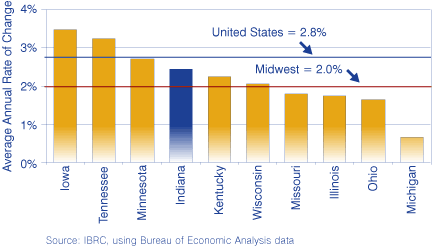
Figure 2: Change in Real Gross Domestic Product by State for Midwestern States, 2001 to 2006
Manufacturing was particularly hard hit during the economic downturn of 2001–2002. Because Indiana has a particularly high percentage of its GDP and employment associated with manufacturing, it was particularly vulnerable to job losses.
For many sectors, the Midwestern states have approximately the same proportions as the United States. The size of the health care sector, construction and utility sector, and the transportation and trade sector are about the same for all Midwestern states and the nation. In other sectors, the differences are more dramatic. Manufacturing, for example, comprises about 12.2 percent of the U.S. output, but 28.1 percent of Indiana's economic output. Indiana's professional and business service sector, one of the faster growing sectors in the U.S. economy, is less than half that of Illinois and about half that of the United States.
One might say that Indiana's industrial composition is overbalanced in favor of manufacturing, especially in durable goods manufacturing. Indiana's growth in durable goods manufacturing fell below the U.S. average from 2001–2006. The relative emphasis in durable goods manufacturing, plus the slower than average growth, serves to drag the average growth down. It is no surprise that Michigan, at the bottom of the U.S. growth in durable goods manufacturing is also at the bottom of the Midwestern states in terms of GDP by state (see Figure 3).
Figure 3: Real Output Growth for Durable Manufacturing, 2001 to 2006
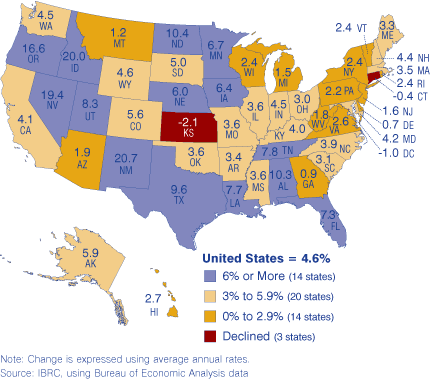
Relative to other states, the picture for nondurable manufacturing growth is much better. Indiana ranks in the top tier of states with robust growth in that sector, as shown in Figure 4. This growth of the nondurable sector is fueled, by and large, by a strong upswing in the manufacturing of chemicals. This should come as no surprise by those who have promoted the life science industries in Indiana, as pharmaceutical manufacturing is an industry under the rubric of chemical manufacturing.
Figure 4: Real Output Growth for Nondurable Manufacturing, 2001 to 2006
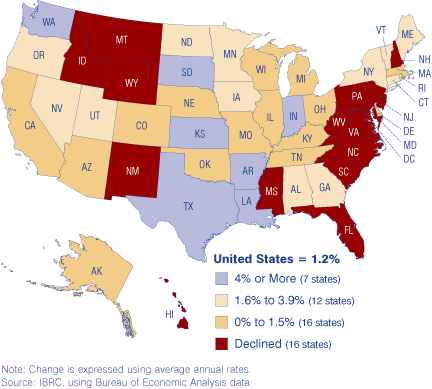
Indeed, the life sciences can also claim that, were it not for the growth in the manufacture of medical devices, an industry that falls within “miscellaneous manufacturing,” the performance of Indiana's durable goods sector would have been considerably worse.
Put another way, manufacturing in Indiana isn't dying … it is transforming. While the output of motor vehicles and parts, as a proportion of Indiana's state GDP, fell from 5.0 percent to 4.1 percent from 2001 to 2005 (the latest data available for subsectors), both durable and nondurable manufacturing output increased as a proportion of state GDP by 0.6 percentage points. The composition of manufacturing, however, has undergone significant changes. Chemical manufacturing, as a proportion of state GDP increased 1.2 percentage points from 2001–2005. Miscellaneous manufacturing increased 0.6 percentage points in the same period. As Figure 5 shows, primary metal manufacturing also registered a strong performance; it increased as a proportion of state GDP by 0.4 percentage points between 2001 and 2005.
Figure 5: Leading Indiana Manufacturing Industries—Five Industries with Increasing Output, 2001 to 2005
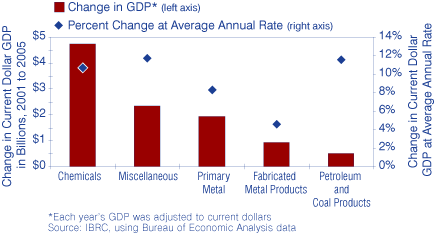
On the service sector front, Indiana has not kept pace with the nation or its Midwestern neighbors. For two of the fastest growing sectors—namely, professional and business services and information, education and other services—Indiana's growth rate is below the national average, as Figures 6 and 7 show. Given that Indiana's professional and business service sector is relatively small and in the bottom quartile of growth rates, it is likely that Indiana will continue to lag behind in this faster growth sector.
Figure 6: Real Output Growth for Professional and Business Services, 2001 to 2005
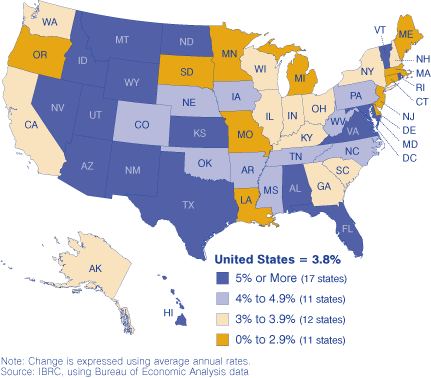
Figure 7: Real Output Growth for Information, Education and Other Services, 2001 to 2005
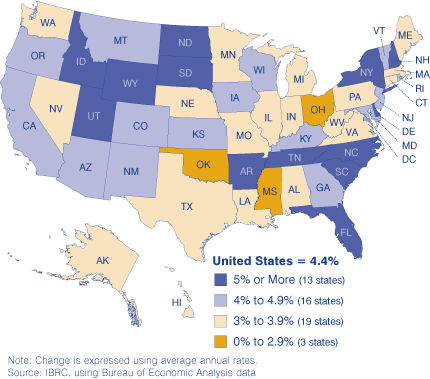
Despite the slower than average output growth in professional and business services, this sector registered the greatest rate of employment gains from 2001–2005. (2) Employment gains in health care and information, education and other services also gained jobs at an above average rate. Figure 8 charts the rate of economic output by industry (or GDP by industry) on the horizontal axis and the rate of employment growth by industry on the vertical axis for each Midwestern state. (The size of the bubble denotes the relative magnitude of compensation per job for that sector.) The almost unexpected conclusion drawn from these graphs is that sectors can lose employment at significant rates, but still increase output. These graphs also show that, in terms of wages and benefits, a manufacturing job is worth over twice that of a job in information, education and other services—at least in Indiana.
Figure 8: Average Annual Change in Real GDP and Employment by Industry, 2001 to 2005
These graphs spark many questions regarding the nature of the shifts in employment and income in the state. The follow-up article will explore some of the trends in employment and income for the country as a whole, Indiana's Midwestern neighbors and Indiana counties.
Notes
- Morton J. Marcus, “Earnings per Job Growing Better than Number of Jobs,” InContext, June 2007, 8(6).
- In order to keep a consistent time frame across axes, the years 2001 to 2005 were used: employment data was not yet available for 2006 at the time of writing.
Timothy F. Slaper, Director of Economic Analysis
Indiana Business Research Center, Kelley School of Business, Indiana University

